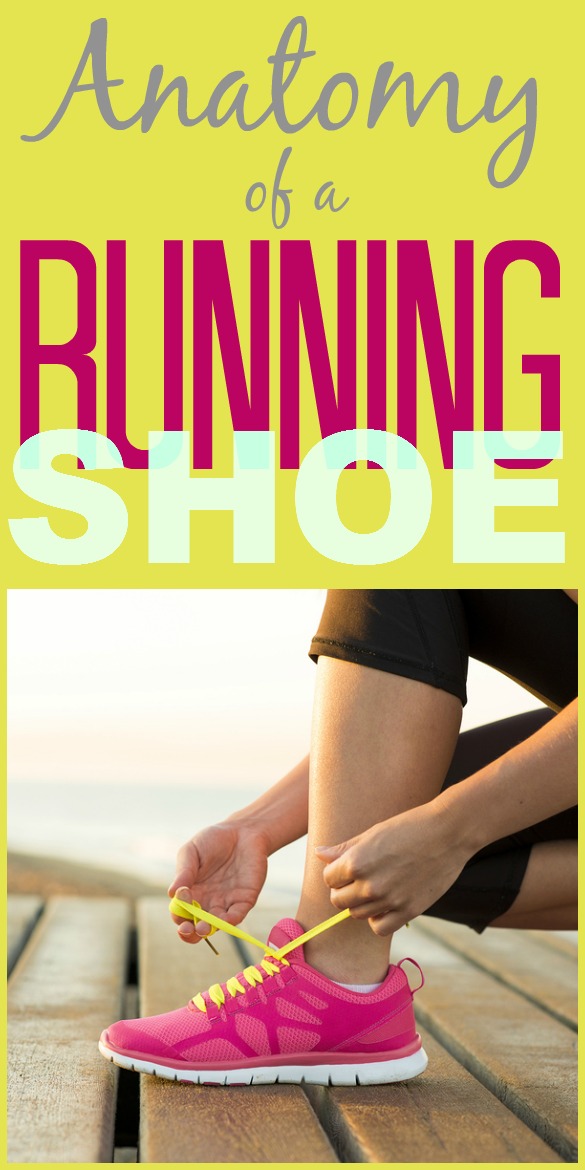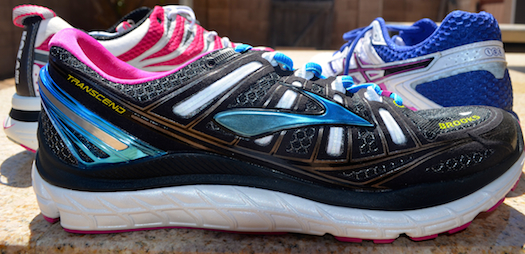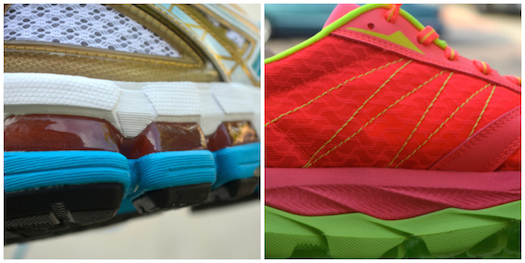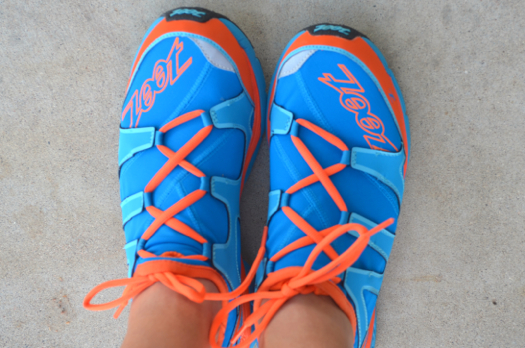Anatomy of a Running Shoe
 While you’re shopping for your new running shoes (because now you’ve got the expert tips, right?), you’ll likely hear your sales associate throw around the lingo of the trade: “heel-toe drop,” “midsole,” “bends.” But what does it all mean? Never fear: we’ve got a crib sheet to help you learn the ins and outs of your running shoes.
While you’re shopping for your new running shoes (because now you’ve got the expert tips, right?), you’ll likely hear your sales associate throw around the lingo of the trade: “heel-toe drop,” “midsole,” “bends.” But what does it all mean? Never fear: we’ve got a crib sheet to help you learn the ins and outs of your running shoes.
Arch
A running shoe specialist will be able to tell you what “arch type” you have: normal, high or flat. Later in this series, I’ll teach you how you can determine this on your own. For now, let’s talk about what it means for your shoe selection:
Normal and flat arches tend to pronate more, meaning your foot collapses inward when you step down. Though this absorbs shock in the foot, it also causes knees and hips to fall out of alignment, leading to injury. For these runners, a category of shoes called stability or motion control will help prevent that pronation from taking place. These shoes usually include fortified support in the midsole (that area under your arch).
For those with high arches, a category of shoes called neutral will likely be the best bet. These don’t have the extra midsole support, but instead carry extra shock absorption to compensate for what the high arches lack.
For more information on stability, motion control and neutral shoes, check out this video from Competitor. There are additional sub-categories of shoes — race flats and minimalist, for example — which we’ll discuss next week in greater detail.
Bends
If a sales clerk tells you to “check the bends,” press your toes into the ground while raising your heel. The “bends” are the flex points of the shoe, and they should align with where your feet naturally bend. If the bends feel stiff or off-kilter, it’s not the right shoe for you, as the shoe will decrease your natural range of motion, leading to injury.
Heel-Toe Drop
Also known as “offset,” this is the measurement of how much the sole declines (or “drops”) between the heel and forefoot. The higher the measurement, the higher your heel sits off the ground in relation to your toes. “Zero drop” means a shoe is flat, so the heel and toe are on the same level. A drop of 12 mm means your heel sits 12 millimeters higher than the toe.
Traditional running shoes measure around 8 to 12 millimeters, though lower numbers can easily be found in your local running store. The lower the heel-toe drop, the more your body will be encouraged to land with a midfoot strike, which is considered to be the most efficient and injury-proof stride; however, if you’ve been wearing 12-millimeter shoes without issues or injury, don’t mess with a good thing. Suddenly changing to a pair of shoes with a significantly lower heel-toe drop can cause injury, too.
Instep
The raised section along the top of your foot between your toe and ankle is known as the instep. When selecting shoes, you want a pair that fits snugly along the instep. The caveat, however, is finding a pair that isn’t so snug it suffocates. If you feel a “hot spot,” or an area where there is tightness or pressure, you’re likely going to end up with chafing and/or blisters on your first run in those shoes.
Size
A general unit of measurement for your foot. Your shoe size is not set in stone. Due to differences in design, you may wear a size 8 in Asics and a size 9 ½ in Skechers. Be willing to “size up” if a pair doesn’t fit quite right.
Sole
The material within the sole of your shoe will affect performance during your run. Put your hand inside the shoe and press on the sole at the heel and at the toebox — the greater the indentation, the more cushioning you’ll get from that shoe.
More cushioning is not always better. Contrary to what logic may dictate, the shock absorption from extra cushioning does not always prevent injuries. Super-cushiony shoes may also degrade faster, meaning you’ll have to replace them more often.
Toe box
The curved area at the top of the shoe encompassing the widest part of your foot to your toes. You want enough room in the toe box to be able to wiggle your toes freely, as well as a thumb’s length of space between your longest toe (which may not be your big toe!). This allows ample space for your feet to swell while running.
Tongue
The strip of shoe that fits underneath the laces is referred to as the tongue. Though most people don’t pay attention to this part of the shoe, take a second to notice where it falls on your foot before and during a test run. If it slips to one side, it may become a nuisance during your longer runs. Some brands include a loop on the tongue to prevent slippage, while others, like Zoot, do away with the tongue completely.
Tread
Check the bottom of the shoe. What do you see? The tread, or the pattern along the bottom of the shoe, should align with the type of running you do. If you’re taking to the trails, you want a tread that has lots of teeth and lugs to give you sufficient grip on loose, muddy surfaces. If you’re on the road or sidewalk, you don’t need as much traction.
Upper
Typically considered the “fun” part of the shoe, the upper is the colorful portion of the shoe that attaches to the sole and covers your foot. Uppers are made from a variety of materials: synthetic leather for protection from rocks and dirt; mesh for breathability; knits and fabrics for a seamless, chafe-free experience. Many uppers also include reflective materials for safety.
What other questions do you have about selecting the right pair of running shoes? Let me know, and I’ll answer them in this series! —Susan




